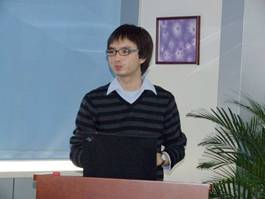“Probing Dirac Fermions in Graphene”的学术报告
应谢晓明研究员邀请,复旦大学物理系张远波教授将来我所作“Probing Dirac Fermions in Graphene”的学术报告,请大家积极参加!
报告时间:2011.5.4, 14:00-15:00
报告地点:8号楼508
Probing Dirac Fermions in Graphene
Prof. Yuanbo Zhang (张远波教授)
Dept. of Physics, Fudan University (复旦大学物理系)
Graphene, a single atomic layer of carbon, is a unique two-dimensional quantum material where electrons behave as massless particles (Dirac fermions) with an effective speed of light equal to c/300. This provides an interesting analogy to the high energy relativistic quantum mechanics in a condensed matter system. In this talk I will discuss our experiments probing the novel quantum phenomena arising from the “relativistic” nature of the quasiparticles in graphene. I will also show that, with one more layer added, the graphene bilayer is another intriguing system whose electronic structure can be controlled by electrical gating.
张远波简历
张远波,河南信阳人。2000年北大技术物理系学士。2006年纽约哥伦比亚大学物理系博士,同年获加州大学伯克利分校Miller Fellowship,从事博士后研究至今。2009年起被聘为复旦特聘教授,博士生导师。张远波教授之前的工作主要集中在石墨烯的制备,电学输运特性,扫描隧道能谱,以及远红外能谱的测量。他与合作者在2005年的工作(以及英国的Geim实验组的工作)引领了全球对石墨烯的研究。从此以后他一直活跃在这个领域的前沿。目前的研究方向包括:
Ø  研究在石墨烯(graphene)中相对论效应对电子影响,包括由此引起的反常量子霍尔效应(quantum Hall effect),准自旋物理(pseudo-spin physics)等等。发展新的样品制备方法提高样品质量,在这个基础上用精细测量方法探寻二维电子系中的电子-电子相互作用,以及可能由此引起的新的有序电磁结构。
研究在石墨烯(graphene)中相对论效应对电子影响,包括由此引起的反常量子霍尔效应(quantum Hall effect),准自旋物理(pseudo-spin physics)等等。发展新的样品制备方法提高样品质量,在这个基础上用精细测量方法探寻二维电子系中的电子-电子相互作用,以及可能由此引起的新的有序电磁结构。
Ø 发展新的样品制备和探测手段来研究其它低维度系统的结构和电磁性质。这些系统包括(自然存在或人工生长的)单晶界面,自组装的分子单层(self-assembled monolayer)等等。根据它们不同的性质,研究内容涵盖广泛,从半导体物理,强关联体系,到最近受到很多关注的“狄拉克材料(Dirac Material)”(石墨烯是其中的一种)。
Ø 我们将在极端物理条件下(极低温度,超强磁场)用电子输运的办法来观察所有这些低维电子体系的电磁特性,寻找可能存在的新的量子基态。与此同时我们将发展低温超高真空中的扫描隧道显微镜和原子力显微镜技术,在原子层级来研究低维度纳米结构里电子和自旋的有序量子态。基于这些研究,我们还将探索这些低维度结构作为新型纳米器件的可行性。
主要奖励:
Miller Fellowship, 加州大学伯克利分校 (2006)
Charles H. Townes Fellowship, 哥伦比亚大学 (2005)
Selected Publications:
1. Y. Zhang*, V. W. Brar*, C. Girit, A. Zettl and M. F. Crommie, “Spatial Charge Inhomogeneity in Graphene” Nature Physics, in press.
2. Y. Zhang*, T.-T. Tang*, C. Girit, Z. Hao, M. C. Martin, A. Zettl, M. F. Crommie, Y. R. Shen and F. Wang, “Direct Observation of a Widely Tunable Bandgap in Bilayer Graphene” Nature 459, 820 (2009).
3. Y. Zhang, V. W. Brar, F. Wang, C. Girit, Y. Yayon, M. Panlasigui, A. Zettl, M. F. Crommie, “Giant phonon-induced conductance in scanning tunneling spectroscopy of gate-tunable graphene” Nature Physics 4, 627 (2008).
4. F. Wang, Y. Zhang, C. Tian, C. Girit, A. Zettl, M. F. Crommie, Y. R. Shen, “Gate-Variable Optical Transitions in Graphene” Science 320, 206 (2008).
5. Y. Zhang, Z. Jiang et. al., “Landau Level Splitting in Graphene in High Magnetic Fields” Phys. Rev. Lett. 96, 136806 (2006).
6. Y. Zhang, Y.-W. Tan, H. L. Stormer, P. Kim, “Experimental Observation of Quantum Hall Effect and Berry’s Phase in Graphene” Nature 438, 201 (2005).
7. Y. Zhang, J. Small, M. Amori, P. Kim, “Electric Field Modulation of Galvanomagnetic Properties of Mesoscopic Graphite” Phys. Rev. Lett. 94, 176803 (2005).